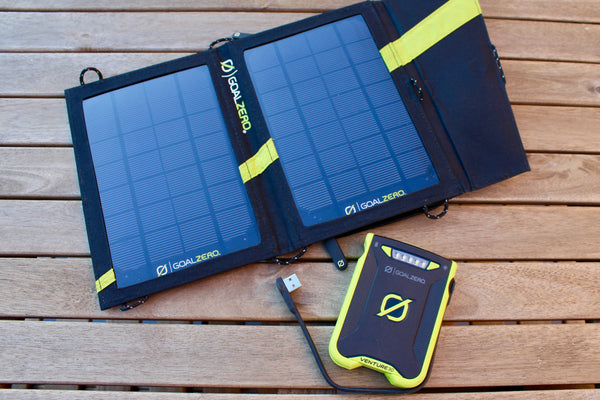
Portable Chargers & Solar Power Guide
Extended, multi-day bushwalks and treks are now often accompanied by an array of ever more power hungry, battery powered devices, for communication, navigation or entertainment, all of which may require recharging at some time during the trip when access to mains electricity is limited or impossible. There are a number of portable solar chargers available which utilise the free power of the sun to help with this to varying degrees.
Considerations when looking at portable solar chargers are:
· Solar panels – size and output
· Batteries - storage capacity
· Weight
· Price
Solar Panels
Measurement of Power
Power is measured in Watts and the larger the solar panel, the more power it will generate. More useful solar chargers have solar panels of between three and seven Watts. Though some solar chargers exist with a one Watt panel, realistically they are a relic of a bygone era belonging to the iPod Mini and Nokia 6100 and just too small to cope with the demands of modern electronic gadgets.
Most lightweight style solar charges have panels which output around 5 Volts so that they have the voltage differential necessary to charge devices or their own battery, which are mostly 3.7V Lithium Ion (Li-ion). As Watts = Volts x Amps, a higher power panel can deliver a higher current flow at this voltage, giving it the ability to charge faster.
The solar panels are the generators which convert the sun’s rays into electricity to charge batteries and devices. Whilst solar panels are clever technology, they are not miracle workers. Simply, the larger the solar panel the more electricity generated, and therefore the faster the charge or the greater the ability to charge higher capacities. This is an important practical consideration as there will always be a limited amount of day, or sunlight. Modern smartphones run their batteries down within a day, so it is not very useful if a solar charger takes longer than this to recharge it.
Solar Efficiency
A 3W solar panel in good sunshine for one hour should, in theory, provide 3 Watt-hours (3Wh) of power. So, if left in the sun for ten hours it should be capable of generating 30Wh. The Watt-hour is the universal measure of battery capacity and will be discussed later, enabling one to work out the ability and speed of a solar panel to charge a battery.
The wattage stated by the manufacturer is a maximum and assumes best light conditions. Unfortunately solar panels are not very efficient. When charging a battery energy is lost through heat and, in the real world, the sun is rarely at the optimum angle and distance, can be momentarily obscured by passing clouds, be filtered through air pollutants or gets shaded slightly by tree branches. Maximum Power Point Tracker (MPPT) technology is used in some panels to help reduce this loss in less than perfect conditions, however, it can be expected that a solar panel will deliver only 25% of its rated power. So a panel will actually deliver 0.25W per hour for every Watt rated, and that 3W panel, sitting in 10 hours of sunlight, is likely to deliver not 30, but only 7.5Wh, meaning much longer charge times.
What do they charge?
Solar panels do not store charge themselves but are used to charge a rechargeable battery pack which can then hold the charge for use at a later time. Some panels may be used to directly charge the battery of a device, such as a phone or iPod, though smaller panels are unlikely to generate enough current for the device to recognise, or the charge rate will be so slow as to be impractical.
Batteries
Integral and external
Portable solar chargers generally have a battery which the panel charges, either integral (built into the panel) or separate. As well as being charged by solar, all can also be charged by mains or USB.
There are two major reasons for the battery:
1. The battery builds and stores a higher capacity than the panel can deliver directly, which can then effectively be more quickly unloaded into a device.
2. The battery can be used to store energy for use when actually needed, when it is more convenient or when the sun is not shining.
With integral battery solar chargers, such as the Solarmonkey Adventurer, the solar panel’s job is to charge its own internal battery, and devices are always recharged using that storage. This makes the solar charger simple, neat and tidy, but a little less versatile. Because the charge to the device comes from the battery in the charger, there must be already sufficient power within it to begin to charge the device. If the integral battery is low or flat then there will be a delay before it has been charged by solar to a sufficient power (around 25-30% of its capacity) to begin charging the device. In this case the device is likely to continue to lose power for a while and, if it is flat, remain unusable itself for up to an hour or so.
Units with a separate battery are more versatile as the battery pack can be used separate from the solar panel and conveniently carried during urban travel as a backup, recharging from USB or mains. If the solar panel is capable of direct charging devices this can be relied on more in the bush, again leaving the charged battery pack as a backup. Most solar chargers can charge their own battery and a device simultaneously (though the Powermonkey Explorer cannot) and some, such as the Goal Zero Guide 10, can charge multiple devices at one time. Bear in mind, however, that as there is a limit to the power provided by the panels, the more devices added, the longer the charge time for each.
Battery types
Lithium Ion (Li-ion) 3.7V batteries are the most common type used in solar chargers. Li-ion are lightweight, hold their charge for a long time and have a lifespan of around three years (ever notice how your smartphone charge doesn’t last as long as it did when new?). They do not need to be charged and discharged fully each time and should be stored with a partial (c60%) charge.
The Goal Zero Guide 10 is an exception in that its separate battery pack uses Nickel-Metal Hydride (NiMH) batteries. NiMH batteries are a little heavier, have a voltage of 1.2V and are used as multiples (in this case four) in series to create a higher voltage (of 4.8V). Their advantage is that they come in traditional battery sizes such as AA or AAA which can be used and interchanged in hand-held GPS, torches or Steripens. Traditionally NiMH batteries self-discharge at a much higher rate so are best used and charged regularly, though Goal Zero batteries and newer technology Sanyo Eneloop NiMH batteries have been developed with a very low self-discharge rate. They benefit from being fully discharged and charged occasionally and have a longer useful life, of up to five years. As NiMH batteries are readily available, they are easily replaceable or added to in order to gain more storage capacity.
Battery capacity
When discussing relatively low powered batteries the common method of measuring battery capacity is “milliamp-hours” (mAh) (a millamp is one thousandth of an amp). It is not however the true measure of “energy capacity” (or power) of a battery as it doesn’t take into account the battery’s voltage. A better and more universal measure is the Watt-hour, which does take voltage as well as current into account (Wh = Ah x V). Therefore two batteries of 2,200mAh each, but one with a voltage of 3.7V and one at 5V, will have different energy capacities, of 8.1Wh and 11Wh respectively. The battery capacities of the solar charger batteries can be found in the table at the end of this guide.
Solar charger battery capacities range from 8.1Wh for the Goal Zero Switch 8, to 33.3Wh for the Powermonkey Extreme. For a solar charger it is important that the battery size is balanced by an adequately sized solar panel, otherwise the long recharging times from solar will become unreasonable and impractical. Larger capacity (and therefore heavier) batteries are best suited for shorter trips, or trips when the sun is less likely, so the battery can be pre-charged from mains and then may have enough capacity to cope with the demands over a few days without recharging quickly or fully. For longer trips where there will be an increased reliance on solar energy it is better to look at a larger solar panel, which is capable of recharging its (maybe smaller) battery, or batteries, more quickly and regularly.
Solar charging speeds
Taking into account the 25% efficiency of solar panel discussed earlier, a rule of thumb is that 1 Watt of solar panel will charge 0.25Wh of battery capacity per hour of good sunshine, giving rise to the following equation to indicate an actual charge time.
Charge Time from Solar (Hrs) = Battery Capacity (Wh) x 4
Solar Panel Output Rating (W)
This may result in a different time than claimed by the manufacturer, though is probably more realistic for use in the real world. Charge times range from around six hours for the Guide 10 Plus to forty four hours for the Powermonkey Extreme, which uses a solar panel of less than half the size to charge a battery three times the size of the Guide 10.
What devices can be charged, and how many times?
The battery packs in the portable solar chargers all have an output voltage of 5V, the ideal voltage to recharge the 3.7V Li-ion batteries used in most hand held devices such as iPods and smartphones. And so will at least partly charge them, depending on their capacity. A Canon DSLR battery, on the other hand, has a battery of 7.4V and so cannot be charged by a 5V charger. Currently the only battery to be able to do this is the new Powermonkey Extreme battery which has a separate 12V output port to provide the voltage differential necessary.
Due to inefficiencies in charging (such as energy being lost through heat), it takes 25% more energy to charge a Li-ion battery to its full capacity. Therefore only 80% of the charging battery’s capacity will be used to charge a phone or iPod’s Li-ion battery. With this in mind the equation below gives an indication of the number of times the device can be charged from one of these batteries:
Number of complete charges = Charging Battery Capacity (Wh) x 0.8
Device Battery Capacity (Wh)
Battery capacities of common devices are listed in the chart accompanying this guide along with number of charges which can be expected from each charger.
Device charging speed
The speed at which a device (phone, iPod etc) charges depends not upon the charger, but the device itself, which is designed to draw up to a maximum amount of current, regardless whether more is supplied. For example, a smartphone still only draws around 600mA even if its mains charger provides 1,200mA. The USB outlet from a laptop delivers 500mA, which means that the phone will simply charge a little slower from a laptop than mains. The outlet currents supplied by the charger batteries are listed in the accompanying chart. Depending on the demands of the device, the slowest battery charge one could expect (Powermonkey Discovery at 500mA) would be the equivalent to charging from the USB on a laptop. All of the others should charge smartphones and iPods at the same rate as they would from the mains. All supply a current less than an iPad takes from the mains, so charge (or part charge) of an iPad will always be slower, though Goal Zero offer the fastest at 1,000mA.
Weight
Most portable solar chargers and their battery packs have a weight of between 400g and 500g. Carrying a smartphone, iPod, Kindle and GPS is likely to add another half kilo to your pack. Whilst weight is an important consideration if the charger is to be carried for a length of time, it is more important to choose a solar charger which is capable of charging what you want, when you want. Choosing a charger because it is 150g lighter than another could result in a kilogram of electronic gadgetry quickly becoming dead weight, which would have been better left out altogether.
Weights stated on packaging and in specifications can be misleading, the Solarmonkey Adventurer including its padded case weighs 50% more than stated, at 400g, whereas the Powermonkey Extreme actually weighs 50% less, at 500g!. Actual weights listed in the accompanying chart include solar panels, battery, cables and case, but leaves out any mains charging items. In effect, it represents the kit one would reasonably expect to take on an extended self-supported trip or hike.
Tips for using solar chargers
· Start off the trip with the charger’s battery, and all devices, fully charged from mains or USB.
· Make the most of sunshine. Always be charging or topping up something with your solar panel.
· Position, position, position. When stationary, angle solar panels perpendicular to the sun and move them around to follow its track. When hiking, a panel still works better strapped to the outside of a pack than inside it.
· Avoid shade, even a little bit, falling on the solar panels.
· Change from the ‘urban’ approach to charging. Charge ‘little and often’ and don’t allow devices to run down fully before plugging in.
· When the battery is full, charge devices direct from solar, if possible, and keep the battery as a backup for sunless days.
· Solar chargers are even less efficient when behind glass.
· The most powerful solar panels are heavier, as are higher capacity batteries.





